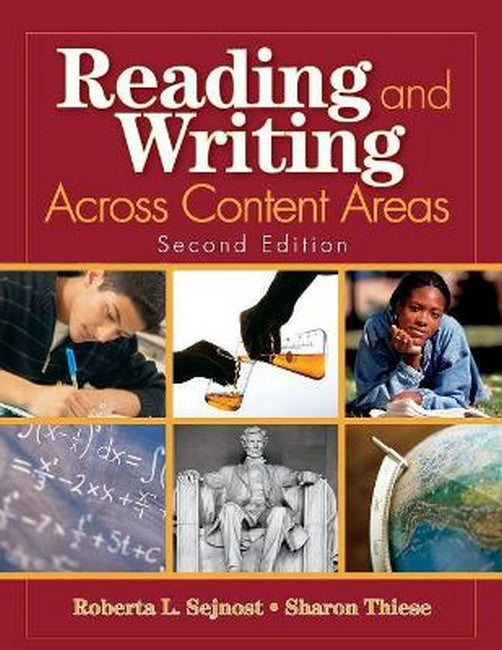Roberta L. Sejnost is a university professor and literacy consultant who has taught secondary-level courses in social studies, reading, and English, and college-level courses in literacy, authentic assessment, brain-based learning, multiple intelligences, and cooperative learning. A nationally recognized staff developer and certified trainer, Sejnost has presented at over 200 educational conferences across the country. In 2003, she received the Reading Educator of the Year award from the Illinois Reading Council. Sejnost received a master of education degree from the University of Illinois at Chicago and a doctorate of education in curriculum and Instruction from Loyola University, Chicago. Sharon Thiese currently teaches writing at Lewis University, Romeoville, Illinois, and graduate classes for Aurora University, Aurora, Illinois. She is also certified in gifted education and a member of Illinois Association for Gifted Children. In addition, Thiese is a certified trainer in gifted education, authentic assessment, multiple intelligences, portfolios, differentiation, and reading and writing across content areas, and she has presented at numerous local and statewide workshops and conferences. Thiese received a master of arts in English from Northeastern University and a master of arts in writing from National-Louis University, Chicago. She taught English and writing at Geneva High School in Geneva, Illinois, and has been Geneva Community Unit 304's high school educator of the year. She is also recognized in Who's Who of American Educators.
Request Academic Copy
Please copy the ISBN for submitting review copy form
Description
Preface Acknowledgments About the Authors 1. Creating the Framework for Reading Literacy and Content Area Literacy: What Are They? The Status of Literacy Today What Can Teachers Do to Foster Literacy? Strategic Readers Guiding the Strategic Reader Matching the Reader and the Text Interpreting the Text Chapter Summary Computer Connections Teacher Tips 2. Setting the Framework for Writing Introduction The Writing Process Creating Terms for Writing Shaping: Organizational Approaches Shaping and Drafting the Content Revising Journals and Learning Logs Writing for Standardized Tests Chapter Summary Computer Connections Teacher Tips 3. Keying in to Vocabulary Principles of Effective Vocabulary Instruction Teacher-Centered Strategies Student-Centered Strategies Chapter Summary Computer Connections Teacher Tips 4. Strategies for Comprehension What Makes a Strategic Reader? The Reading Process Pre-Reading Strategies During-Reading Strategies After-Reading Strategies Chapter Summary Computer Connections Teacher Tips 5. Integrating Reading and Writing in the Classroom The Reading-Writing Connection Characteristics of Effective Reading and Writing Strategies Fostering Critical Understanding Engaging Readers and Writers in the Process of Revision Fostering Prior Knowledge Encouraging Students to Become Personally Involved Asking Students to Invoke Personal Feelings Chapter Summary Computer Connections Teacher Tips 6. Research Writing Nontraditional Research Alternative Research Research Skills Traditional Research The Research Process Chapter Summary Computer Connections Teacher Tips 7. Reading and Writing: Where It Can Lead Formal Assessments in Reading Formal Assessments in Writing Alternative Assessments Test-Taking Strategies Study Strategies for Good Test Performance Chapter Summary Computer Connections Teacher Tips Bibliography Index
"This text makes a teacher feel empowered rather than overwhelmed; not many texts truly achieve this! The strategies are applicable and fundamental because they help the students with reading and writing in every class." -- Sarah Luedtke, Study Seminar Teacher/504 Case Manager "This practical compendium of literacy strategies should be required reading for all middle and high school teachers. The ready-to-use blackline masters are real timesavers for busy educators." -- Ann Kimpton, Literacy Department Chair "This bountiful resource provides educators with the tools they need to help students increase their reading and writing achievement in all subject matter classes . . . discovering the new, updated version of Reading and Writing Across the Content Areas is like finding a pot full of gold!" -- Judy Rhoads, Acceleration/Enrichment Coordinator "This is a wonderful resource for teachers! It includes many research-based reading strategies for classroom use. If you're looking for easy-to-use, hands-on strategies with easily accessible handouts, this is the book for you!" -- Ann Peters, Reading Dept. Chairman "We often hear middle and high school teachers are frustrated because their students can't understand the textbooks or can't write effectively about their particular content. This book will provide both the framework for solving this dilemma and the specific, practical classroom practices that teachers can use each day to help students become more competent readers and writers." -- Douglas Johnson, Assistant Superintendent "Every middle school and secondary teacher should have a copy of this book. It not only provides the theoretical basis for each strategy but it also effective instructions for use of the strategies in the classroom." -- Dorothy Giroux, Program Director, Initial Teacher Preparation Program "Reading and Writing Across Content Areas is a wonderful book for content area classroom teachers. Throughout the book, the strategies are explained well and are easy to understand and implement. When you read the cartoons throughout the book, you know that the authors understand children and their teachers." -- Marie-Elena Meagher, Middle School Social Studies Teacher "The ideas and strategies in this book are practical and useful for all discipline areas and teaching styles. The novice teacher as well as the veteran will find excellent handouts, graphic organizers, and new and creative ideas for presenting information. Students of all levels will reap the benefits of these models." -- Julie Hepker, Language Arts Teacher

